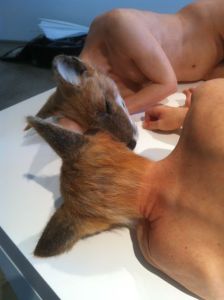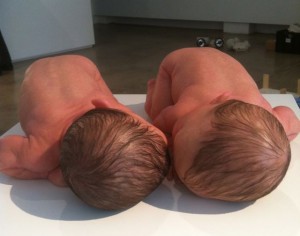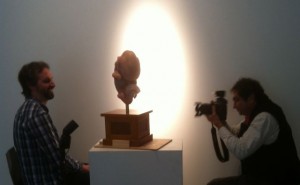Archive for June, 2013
Sam Jinks exhibits at Venice Biennale satellite exhibition, Personal Structures
Jun 6th

Unsettled Dogs, by Sam Jinks
The Melbourne artist Sam Jinks has been included in Personal Structures: Time, Space, Existence, a collateral event of the 55th Venice Biennale, which opened on June 1, 2013.
I have interviewed Jinks twice before, so I thought I would dig out my 2012 interview notes with him and share them here on my website.
First of all, here is a link to Jinks’ exhibition at Sullivan and Strumpf Fine Art last year. And here is a link to my story which appeared in the Daily Telegraph. The artist’s gallery made the announcement about Venice, which you can read here.
The works included in Jinks’ 2012 exhibition included the one at left, titled Unsettled Dogs. I found this work, and others in the show, strangely moving. Unsettled Dogs is two separate sculptures, lying close together on a plinth. Although they have foxes’ heads, they have human bodies. And both heads and bodies are rendered in painstaking and perfect detail by the artist himself.
I asked Jinks if he had used real foxes’ heads or if they were models he made himself.
“That would be the sensible thing to do!,” Jinks replied, adding that he had made the foxes’ heads himself.
“I don’t know, there’s something about hand-made things,” he said.
Unsettled Dogs was partly inspired by the cynocephalus, the dog-headed human which exists in the mythology of many world cultures. The cynocephalus was described as irrational and argumentative, and Jinks has used them as a symbol for the high level of emotion involved in human inter-communication.
“People give a real illusion of being civilised,” he said. “They do a very good job most of the time, but it doesn’t take as much as you would think to get someone to tip over the edge.”
In the same exhibition was a rather fascinating sculpture called Time Machine, showing a 42-day-old human fetus in perfect, opalescent detail although massively scaled up from the real thing, of course.
Jinks is interested in how the fetuses of different types of animals are very alike until a certain point when they clearly start to become what they are eventually going to be at birth.
“I was looking at doing different animals because they all look so similar,” Jinks said.
“Then there’s points where they all start to diverge and completely separate.”
To make the embryo model, Jinks worked from electron microscope photographs in a book about embryonic anatomy.
“There’s real question marks about when you get a person ‘arriving’, because a lizard one is so similar,” he said.
“There’s this big mixing pot right at the beginning [of life], and it could go anywhere.'”
Interestingly, Jinks also spoke of his fascination with his two young children. He had noticed how each of them had “arrived” at different times. By arriving, he meant arriving as a sentient human being with whom one could interact.
So now Jinks’ work is being seen in Venice, and I’m sure that this sensitive and technically rigorous artist will attract a great deal of favourable attention.
Elizabeth Fortescue, June 6, 2013

Untitled, by Sam Jinks

Time Machine, by Sam Jinks (Sam Jinks being photographed by Daily Telegraph photographer Bob Barker, 2012
